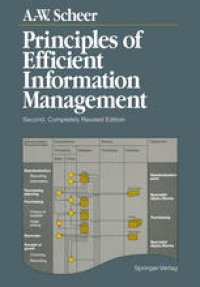
Ebook: Principles of Efficient Information Management
- Tags: Business Information Systems, Organization/Planning, Information Systems Applications (incl. Internet)
- Year: 1991
- Publisher: Springer-Verlag Berlin Heidelberg
- Edition: 2
- Language: English
- pdf
The first edition of this book appeared in the Federal Republic of Gennany in 1984. and in English translation as "Computer: A Challenge for Business Administration" in 1985. This book. which is a translation of the fourth Gennan edition. has been comprehensively revised. As a result both the character and the expected audience of the book have changed. which is reflected in the alteration to the title. This book adresses itself to issues arising from the research areas of both infonnation systems and computer science. Computer science departments are primarily concerned with the development of EDP techniques. and the business economics aspects remain largely Ignored. The emphasis in infonnation systems departments is placed on the investigation of the business economic impact of the use of already existing systems. This strongly empirical approach is accompanied by a disinclination to consider actual system deSign: this is considered the responsibility of the software houses. This partitioning. however. leaves untapped the considerable potential which could be realized by an interdisciplinary approach from computer science and business economics. An isolated approach neglects both the effects that business economics can have on the implementation of EDP techniques. and the structural impact of EDP on business economics.
The use of EDP techniques is increasingly changing business economics issues and problem-solving approaches, with far-reaching effects on the structure and market position of the firm. At the same time business economics methods and techniques can be employed to achieve an optimal application of information technology. This book examines the influences in both directions betweeen computer science and business economics, for concrete information and communication techniques such as the use of databases, networking, CASE and interactive processing. The important results are incorporated and summarized in an EDP-oriented business economics information model. In comparison with the first edition of the book, new EDP techniques, such as expert systems and data modelling, receive greater attention. The entire contents have been completely revised, restructured and extended. The book provides a suitable basis for courses on "Information Systems for Business Economics" or "Information Management". Practical examples and the emphasis on applications interdependences renders the book also of interest to practitioners from specialist economics and EDP departments. The reciprocal influences between EDP and business economics are valid not only in theory but also for practical use in the enterprise. This book is therefore addressed not only to students, but also to those engaged in areas of theoretical or practical business economics.
The use of EDP techniques is increasingly changing business economics issues and problem-solving approaches, with far-reaching effects on the structure and market position of the firm. At the same time business economics methods and techniques can be employed to achieve an optimal application of information technology. This book examines the influences in both directions betweeen computer science and business economics, for concrete information and communication techniques such as the use of databases, networking, CASE and interactive processing. The important results are incorporated and summarized in an EDP-oriented business economics information model. In comparison with the first edition of the book, new EDP techniques, such as expert systems and data modelling, receive greater attention. The entire contents have been completely revised, restructured and extended. The book provides a suitable basis for courses on "Information Systems for Business Economics" or "Information Management". Practical examples and the emphasis on applications interdependences renders the book also of interest to practitioners from specialist economics and EDP departments. The reciprocal influences between EDP and business economics are valid not only in theory but also for practical use in the enterprise. This book is therefore addressed not only to students, but also to those engaged in areas of theoretical or practical business economics.
Content:
Front Matter....Pages I-X
EDP-Orientation of Business Economics....Pages 1-11
Business Economics Implementation and Structuring of EDP Techniques....Pages 12-178
EDP-Oriented Business Economics Solutions....Pages 179-255
The EDP-Oriented Business Economics Information Model....Pages 256-269
Back Matter....Pages 270-307
The use of EDP techniques is increasingly changing business economics issues and problem-solving approaches, with far-reaching effects on the structure and market position of the firm. At the same time business economics methods and techniques can be employed to achieve an optimal application of information technology. This book examines the influences in both directions betweeen computer science and business economics, for concrete information and communication techniques such as the use of databases, networking, CASE and interactive processing. The important results are incorporated and summarized in an EDP-oriented business economics information model. In comparison with the first edition of the book, new EDP techniques, such as expert systems and data modelling, receive greater attention. The entire contents have been completely revised, restructured and extended. The book provides a suitable basis for courses on "Information Systems for Business Economics" or "Information Management". Practical examples and the emphasis on applications interdependences renders the book also of interest to practitioners from specialist economics and EDP departments. The reciprocal influences between EDP and business economics are valid not only in theory but also for practical use in the enterprise. This book is therefore addressed not only to students, but also to those engaged in areas of theoretical or practical business economics.
Content:
Front Matter....Pages I-X
EDP-Orientation of Business Economics....Pages 1-11
Business Economics Implementation and Structuring of EDP Techniques....Pages 12-178
EDP-Oriented Business Economics Solutions....Pages 179-255
The EDP-Oriented Business Economics Information Model....Pages 256-269
Back Matter....Pages 270-307
....